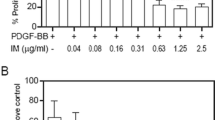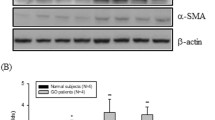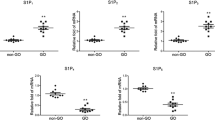Abstract
Purpose
The aim of this study was to detect the effect of the CD40 ligand (CD40L) on the expression of vascular cell adhesion molecule 1 (VCAM-1) and E-Selectin in orbital fibroblasts (OFs) from patients with Graves’ orbitopathy (GO), as well as the signaling pathways involved in this effect.
Methods
OFs were isolated from orbital tissues obtained from patients with severe GO who were undergoing orbital decompression surgery. VCAM-1 and E-selectin RNA and protein expression levels were quantified in OFs stimulated with soluble CD40L (sCD40L). RNA and protein quantification was performed with real-time polymerase chain reaction (PCR) and western blot analysis. Cytoplasmic and nuclear fractions were isolated in order to detect the nuclear translocation of nuclear factor-κB (NF-κB). Signaling pathway inhibitors were applied to determine the pathways involved.
Results
Compared to unstimulated OFs, the mRNA and protein levels of VCAM-1 and E-selectin in OFs incubated with sCD40L were significantly increased. This was observed in dose- and time-course experiments, and the inductive effects of sCD40L were much weaker in OFs from healthy donors. At the same time, we observed that CD40L induced nuclear translocation of NF-κB, also in a dose- and time-dependent manner. The up-regulation of VCAM-1 and E-selectin, as well as the NF-κB nuclear translocation induced by CD40L, was significantly attenuated by inhibitors targeting mitogen-activated protein kinases (MAPKs), phosphatidylinositol 3-kinase (PI3K), and NF-κB.
Conclusions
CD40L demonstrated the ability to up-regulate the expression of VCAM-1 and E-selectin at the pre-translational level in OFs from patients with GO. The MAPK and PI3K pathways and NF-κB may play important roles in CD40L-induced VCAM-1 and E-selectin expression.







Similar content being viewed by others
References
Bahn RS (2010) Graves’ ophthalmopathy. N Engl J Med 362:726–738
Kazim M, Goldberg RA, Smith TJ (2002) Insights into the pathogenesis of thyroid-associated orbitopathy: evolving rationale for therapy. Arch Ophthalmol 120:380–386
Bahn RS, Heufelder AE (1993) Pathogenesis of Graves’ ophthalmopathy. N Engl J Med 329:1468–1475
Marcocci C, Bartalena L, Marino M et al (2002) Current medical management of Graves' ophthalmopathy. Ophthalmic Plast Reconstr Surg 18:402–408
Bartalena L, Tanda ML (2009) Clinical practice. Graves’ ophthalmopathy. N Engl J Med 360:994–1001
Lehmann GM, Feldon SE, Smith TJ, Phipps RP (2008) Immune mechanisms in thyroid eye disease. Thyroid 18:959–965
Van Steensel L, Dik WA (2010) The orbital fibroblast: a key player and target for therapy in Graves’ ophthalmopathy. Orbit 29(4):202–206
Cao HJ, Wang HS, Zhang Y, Lin HY, Phipps RP, Smith TJ (1998) Activation of human orbital fibroblasts through CD40 engagement results in a dramatic induction of hyaluronan synthesis and prostaglandin endoperoxide H synthase-2 expression: insights into potential pathogenic mechanisms of thyroid-associated ophthalmopathy. J Biol Chem 273(45):29615–29625
Smith TJ (2004) Novel aspects of orbital fibroblast pathology. J Endocrinol Investig 27:246–253
Eckstein AK, Johnson KT, Thanos M, Esser J, Ludgate M (2009) Current insights into the pathogenesis of Graves’ orbitopathy. Horm Metab Res 41:456–464
Hwang CJ, Afifiyan N, Sand D et al (2009) Orbital fibroblasts from patients with thyroid-associated ophthalmopathy overexpress CD40: CD154 hyperinduces IL-6, IL-8, and MCP-1. Invest Ophthalmol Vis Sci 50:2262–2268
Sempowski GD, Rozenblit J, Smith TJ, Phipps RP (1998) Human orbital fibroblasts are activated through CD40 to induce proinflammatory cytokine production. Am J Physiol Cell Physiol 274:C707–C714
Zhao LQ, Wei RL, Cheng JW, Cai JP, Li Y (2010) The expression of intercellular adhesion molecule-1 induced by CD40-CD40L ligand signaling in orbital fibroblasts in patients with Graves’ ophthalmopathy. Invest Ophthalmol Vis Sci 51:4652–4660
Yellin MJ, Winikoff S, Fortune SM et al (1999) Ligation of CD40 on fibroblasts induces CD54 (ICAM-1) and CD106 (VCAM-1) up-regulation and IL-6 production and proliferation. J Leukoc Biol 58:209–216
Baglole CJ, Reddy SY, Pollock SJ et al (2005) Isolation and phenotypic characterization of lung fibroblasts. Methods Mol Med 117:115–127
Dussault AA, Pouliot M (2006) Rapid and simple comparison of messenger RNA levels using real-time PCR. Biol Proced Online 8:1–10
Yanagawa Y, Onoé K (2006) Distinct regulation of CD40-mediated interleukin-6 and interleukin-12 productions via mitogen-activated protein kinase and nuclear factor kappaB-inducing kinase in mature dendritic cells. Immunology 117:526–535
Qin H, Wilson CA, Lee SJ, Zhao X, Benveniste EN (2005) LPS induces CD40 gene expression through the activation of NF-kappaB and STAT-1alpha in macrophages and microglia. Blood 106:3114–3122
Salmaso C, Olive D, Pesce G, Bagnasco M (2002) Costimulatory molecules and autoimmune thyroid diseases. Autoimmunity 35:159–167
Montgomery KF, Osborn L, Hession C et al (1991) Activation of endothelial-leukocyte adhesion molecule 1 (ELAM-1) gene transcription. Proc Natl Acad Sci U S A 88:6523–6527
Wong D, Dorovini-Zis K (1996) Regualtion by cytokines and lipopolysaccharide of E-selectin expression by human brain microvessel endothelial cells in primary culture. J Neuropathol Exp Neurol 55:225–235
Jebali J, Jeanneau C, Bazaa A et al (2011) Selectins as adhesion molecules and potential therapeutic target. Arch Inst Pasteur Tunis 88:3–18
Jubeli E, Moine L, Vergnaud-Gauduchon J, Barratt G (2012) E-selectin as a target for drug delivery and molecular imaging. J Control Release 158:194–206
Wenisch C, Myskiw D, Parschalk B, Hartmann T, Dam K, Graninger W (1994) Soluble endothelium-associated adhesion molecules in patients with Graves’ disease. Clin Exp Immunol 98:240–244
Kulig G, Pilarska K, Kulig J, Robaczyk M, Gromniak E (2004) Assessment of soluble E selectin levels in patients with Graves’ disease and thyroid orbitopathy. Przegl Lek 61:1314–1318
Schönbeck U, Libby P (2001) The CD40/CD154 receptor/ligand dyad. Cell Mol Life Sci 58:4–43
Hassan GS, Merhi Y, Mourad W (2012) CD40 ligand: a neo-inflammatory molecule in vascular diseases. Immunobiology 217:521–532
Engel D, Seijkens T, Poggi M, Sanati M, Thevissen L (2009) The immunobiology of CD154-CD40-TRAF interactions in atherosclerosis. Semin Immunol 21:308–312
Bishop GA, Moore CR, Xie P, Stunz LL, Kraus ZJ (2007) TRAF proteins in CD40 signaling. Adv Exp Med Biol 597:131–151
Zhang L, Grennan-Jones F, Lane C, Rees DA, Dayan CM, Ludgate M (2012) Adipose tissue depot-specific differences in the regulation of hyaluronan production of relevance to Graves’ orbitopathy. J Clin Endocrinol Metab 97:653–662
Zhang L, Grennan-Jones F, Draman MS, Lane C, Morris D, Dayan CM, Tee AR, Ludgate M (2014) Possible targets for nonimmunosuppressive therapy of Graves’ orbitopathy. J Clin Endocrinol Metab 99:E1183–E1190
Kotowicz K, Dixon GL, Klein NJ, Peters M, Callard RE (2000) Biological function of CD40 on human endothelial cells: costimulation with CD40 ligand and interleukin-4 selectively induces expression of vascular cell adhesion molecule-1 and P-selectin resulting in preferential adhesion of lymphocytes. Immunology 100:441–448
Mysliwiec J, Oklota M, Nikolajuk A, Waligorski D, Gorska M (2007) Serum CD40/CD40L system in Graves’ disease and Hashimoto’s thyroiditis related to soluble Fas, FasL and humoral markers of autoimmune response. Immunol Investig 36:247–257
Koumas L, Smith TJ, Phipps RP (2002) Fibroblast subsets in the human orbit: Thy-1+ and Thy-1- subpopulations exhibit distinct phenotypes. Eur J Immunol 32:477–485
Feldon SE, Park DJ, O’Loughlin CW et al (2005) Autologous T-lymphocytes stimulate proliferation of orbital fibroblasts derived from patients with Graves’ ophthalmopathy. Invest Ophthalmol Vis Sci 46:3913–3921
Gillespie EF, Raychaudhuri N, Papageorgiou KI et al (2012) Interleukin-6 production in CD40-engaged fibrocytes in thyroid-associated ophthalmopathy: involvement of Akt and NF-κB. Invest Ophthalmol Vis Sci 53:7746–7753
Chakrabarti S, Blair P, Freedman JE (2007) CD40–40L signaling in vascular inflammation. J Biol Chem 282:18307–18317
Acknowledgments
Our work is funded by the National Nature and Science Foundation of China (grant Nos. 81070758 and 81371056). Dr. Stephen J. Atkins from the Kellogg Eye Center at the University of Michigan provided English language assistance in the writing of our paper.
Compliance with ethical standards
ᅟ
Conflicts of interest
The authors declare that they have no conflict of interest.
Research involving human participants
All procedures performed in studies involving human participants were in accordance with the ethical standards of the institutional research committee and with the 1964 Declaration of Helsinki and its later amendments or comparable ethical standards.
Informed consent
Informed consent was obtained from all individual participants included in the study.
Author information
Authors and Affiliations
Corresponding author
Additional information
Hao Wang and Li-Shuang Zhu contributed equally to this work.
Rights and permissions
About this article
Cite this article
Wang, H., Zhu, LS., Cheng, JW. et al. CD40 ligand induces expression of vascular cell adhesion molecule 1 and E-selectin in orbital fibroblasts from patients with Graves’ orbitopathy. Graefes Arch Clin Exp Ophthalmol 253, 573–582 (2015). https://doi.org/10.1007/s00417-014-2902-1
Received:
Revised:
Accepted:
Published:
Issue Date:
DOI: https://doi.org/10.1007/s00417-014-2902-1




